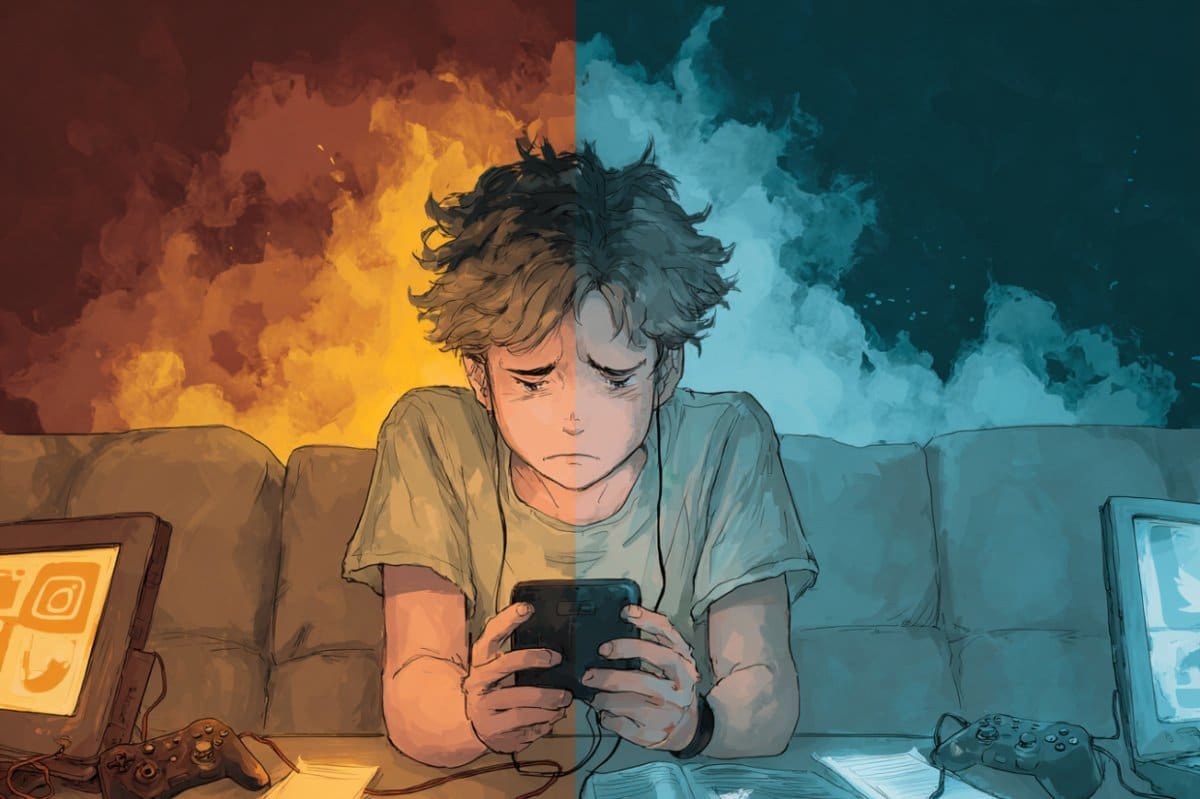Summary: A major new study reveals that teens who develop compulsive patterns of digital use are at higher risk of suicidal thoughts, attempts, and mental health issues. Unlike total screen time, it’s the addictive nature of use—such as distress when not online or using screens to escape—that most strongly predicts poor outcomes.
Youth with high and increasing addiction trajectories for social media, phones, or video games showed up to three times the risk of suicide-related behavior. These findings highlight the need for early, nuanced interventions that target problematic use rather than simply limiting screen time.
Key Facts:
- Addiction vs. Duration: Time spent on screens wasn’t the risk factor—addictive use patterns were.
- Elevated Risk: Teens with increasing addiction trajectories were 2–3 times more likely to report suicidal thoughts and behaviors.
- Behavioral Impact: Addictive use linked to both internalizing symptoms (e.g., anxiety, depression) and externalizing ones (e.g., aggression).
Source: Weill Cornell University
New research found that youth who become increasingly addicted to social media, mobile phones or video games are at greater risk of suicidal thoughts, suicide attempts and emotional or behavioral issues.
The study, published June 18 in JAMA, was led by researchers at Weill Cornell Medicine, Columbia University and University of California, Berkeley.

Unlike previous studies that focused on total screen time at one point in a child’s life, this study looked at how young people’s patterns of compulsive or “addictive” use changed over time.
These patterns included feeling unable to stop using a device, experiencing distress when not using it or using it to escape from problems. In contrast, simply spending more time on screens at 10 years old wasn’t associated with worse suicide-related and mental health outcomes.
“For parents and educators, the discussion around mobile phones and social media has focused on limiting or banning use, but our results indicate more complex factors are involved,” said first author Dr. Yunyu Xiao, assistant professor of population health sciences at Weill Cornell Medicine.
“Clinical trials have shown that limiting cell phone use, for instance during school hours, was not effective in reducing the risk of suicidal behavior or improving other aspects of mental health.”
This study could signal a paradigm shift in how the impact of screen time on youth mental health is addressed.
“Testing interventions that work against other types of addiction may be one way to approach this type of social media and mobile phone use,” Dr. Xiao said.
Dr. John Mann, the Paul Janssen Professor of Translational Neuroscience in Psychiatry and Radiology at Columbia University and the New York State Psychiatric Institute, is senior author on this study.
Quantity Versus Quality
Over four years, the researchers tracked nearly 4,300 youths aged nine to ten when they first started the study. Participants identified themselves as Asian, Black, Hispanic, white or multiracial.
Using machine learning and data from participant interviews, the researchers characterized three addictive use trajectories for social media and mobile phone usage and two for addictive use with video games. When graphed, these trajectories depicted relative levels of addictive behaviors.
By age 14, almost one in three participants had a high addictive use trajectory for social media and one in four for mobile phones. More than 40 percent of the youths had a high addictive use trajectory for video games.
These adolescents were significantly more likely to report suicidal thoughts or behaviors, as well as symptoms of anxiety, depression, aggression or rule-breaking.
The researchers also found that each type of digital activity showed unique patterns of association with suicide-related behaviors and mental health symptoms. For social media and mobile phones, the high and increasing addictive use trajectories were associated with a two to three times greater risk of suicidal behaviors and suicidal ideation compared with the low addictive use trajectory.
The higher use trajectories were also associated with either internalizing symptoms such as anxiousness and depression, or externalizing symptoms, including aggressiveness or inattentiveness.
“Parents may want to pay more attention to how their kids are using their digital devices and consider having them evaluated for signs of addictive use, said co-first author Dr. Yuan Meng, postdoctoral associate in population health sciences at Weill Cornell.
“If an addiction is identified, limiting use of mobile phones and social media for part of the day, may potentially reinforce addictive behaviors, so seeking professional advice is essential.”
Paradigm Shift
This study demonstrated that the total amount of time spent on social media, mobile phones and video games was not associated with future suicide-related or mental health outcomes.
What mattered most was how youth were engaging with screens—especially whether their use showed signs of compulsion, distress or loss of control.
The findings suggest repeated assessment of social media and mobile phones in children entering adolescence for addictive use patterns could be valuable.
“Children who initially display low or moderate trajectories are not typically considered at-risk, but follow-up can detect concerning trends such as development of more severe addictive use over time,” Dr. Xiao said.
Though the study does not prove addictive screen use causes mental health problems—higher addiction use trajectories are linked to roughly double the risk of suicidal behavior in the near future of these teens.
“This calls for further study and evaluation of approaches that have worked for other addictions in children and adolescents for this issue,” Dr. Mann said.
Next, Dr. Xiao and her colleagues plan to extract profiles of children who comprise different trajectories with their demographic and socioeconomic information. The researchers are also developing interventions to address addictive use behaviors at their onset to reduce the likelihood of suicidal behaviors.
Dr. Timothy T. Brown, associate director for research at the Berkeley Center for Health Technology at the University of California, Berkeley, and Dr. Katherine M. Keyes, professor of epidemiology at the Columbia University Mailman School of Public Health, also contributed to this study.
About this mental health and neurodevelopment research news
Author: Barbara Prempeh
Source: Weill Cornell University
Contact: Barbara Prempeh – Weill Cornell University
Image: The image is credited to Neuroscience News
Original Research: Open access.
“Addictive Screen Use Trajectories and Suicidal Behaviors, Suicidal Ideation, and Mental Health in US Youths” by Yunyu Xiao et al. JAMA
Abstract
Addictive Screen Use Trajectories and Suicidal Behaviors, Suicidal Ideation, and Mental Health in US Youths
Importance
Increasing child and adolescent use of social media, video games, and mobile phones has raised concerns about potential links to youth mental health problems. Prior research has largely focused on total screen time rather than longitudinal addictive use trajectories.
Objectives
To identify trajectories of addictive use of social media, mobile phones, and video games and to examine their associations with suicidal behaviors and ideation and mental health outcomes among youths.
Design, Setting, and Participants
Cohort study analyzing data from baseline through year 4 follow-up in the Adolescent Brain Cognitive Development Study (2016-2022), with population-based samples from 21 US sites.
Exposures
Addictive use of social media, mobile phones, and video games using validated child-reported measures from year 2, year 3, and year 4 follow-up surveys.
Main Outcomes and Measures
Suicidal behaviors and ideation assessed using child- and parent-reported information via the Kiddie Schedule for Affective Disorders and Schizophrenia. Internalizing and externalizing symptoms were assessed using the parent-reported Child Behavior Checklist.
Results
The analytic sample (n = 4285) had a mean age of 10.0 (SD, 0.6) years; 47.9% were female; and 9.9% were Black, 19.4% Hispanic, and 58.7% White. Latent class linear mixed models identified 3 addictive use trajectories for social media and mobile phones and 2 for video games.
Nearly one-third of participants had an increasing addictive use trajectory for social media or mobile phones beginning at age 11 years. In adjusted models, increasing addictive use trajectories were associated with higher risks of suicide-related outcomes than low addictive use trajectories (eg, increasing addictive use of social media had a risk ratio of 2.14 [95% CI, 1.61-2.85] for suicidal behaviors).
High addictive use trajectories for all screen types were associated with suicide-related outcomes (eg, high-peaking addictive use of social media had a risk ratio of 2.39 [95% CI, 1.66-3.43] for suicidal behaviors).
The high video game addictive use trajectory showed the largest relative difference in internalizing symptoms (T score difference, 2.03 [95% CI, 1.45-2.61]), and the increasing social media addictive use trajectory for externalizing symptoms (T score difference, 1.05 [95% CI, 0.54-1.56]), compared with low addictive use trajectories. Total screen time at baseline was not associated with outcomes.
Conclusions and Relevance
High or increasing trajectories of addictive use of social media, mobile phones, or video games were common in early adolescents. Both high and increasing addictive screen use trajectories were associated with suicidal behaviors and ideation and worse mental health.






